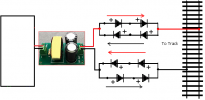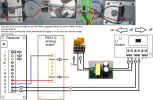Turning or reducing the controller output to three quarters or 75% is of no use.
All this will do, will be to reduce the PWM Duty Cycle ON Time, the voltage out will still be at 24V regardless.
1N5401 3-Amp General Purpose Diode.
Each diode reduces voltage by approximately 0.7 volt.
At any one time only 4 of the 8 diodes are conducting, thus reducing the overall output voltage by around 2.8 volts.
Which now may be enough to get within the tolerance of the working voltage of the receiver.
You could reduce the number of diodes, the risk here, is that the controller has to always be turned to the correct direction, wrong direction and excessive voltage will flow into the receiver.
Could also arrange and fit the diodes into each individual loco, but as you have indicated that you are intending to install the PWM to DC converter to the controller, makes sense to do the exact same with the Diode circuit.
Could always fit a DPDT switch, one position as normal PWM output, other position for converted PWM to DC.




